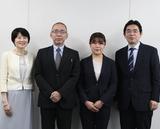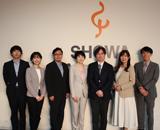August 2019
Innovative Owned Media Powered by the 3DEXPERIENCE Strategy
Dassault Systèmes is a French company that developed the 3D Computer-Aided Design (CAD) software called CATIA, which is used by manufacturers around the globe to design products. A pioneer in spreading the idea of 3D design throughout the world, the company has since become a leader in software technologies for manufacturers, offering concepts such as digital mock-ups (DMU) and Product Lifecyle Management (PLM) in fields that range from design to manufacturing. In 2012, Dassault Systèmes announced the 3DEXPERIENCE platform and created Compass, The 3DEXPERIENCE Magazine, as a new journal to spread their ideas. Arc Communications has been involved in the publication, which provides information half a step ahead of the world to company trend watchers and decision-makers. We sat down with members in charge of translations, interpretations and publicity at Dassault Systèmes to ask about the new journal, as well as their in-house linguistic services.

From left to right:
Hiroaki Baba, Toko Miyagi, Kazuo Hosoe, Mariko Ohsato,
Kiku Kagami, Michiko Matsuda, Hitomi Hirata and Yukiko Sato
- Profile
- Kiku Kagami: Translation Service Japan Manager, Dassault Systèmes K.K.
- Michiko Matsuda: Translation Service Japan, Dassault Systèmes K.K.
- Hitomi Hirata: Translation Service Japan, Dassault Systèmes K.K.
- Yukiko Sato: Senior Manager, PR & Communications Japan, Dassault Systèmes K.K.
- Mariko Ohsato: CEO & President, Arc Communications Inc.
- Hiroaki Baba: Executive Manager, Translation & Localization Division, Arc Communications Inc.
- Kazuo Hosoe: Chief Project Manager, Translation & Localization Division, Arc Communications Inc.
- Toko Miyagi: Interpretation Coordinator, Translation & Localization Division, Arc Communications Inc.
Advocating the 3DEXPERIENCE Platform
Ohsato: Dassault Systèmes is famous worldwide as a software company with extensive achievements. Could you briefly introduce the company for us?
Kagami: Dassault Systèmes is a scientific company--in other words, science is our foundation. We currently have around 17,000 employees, but that number is growing every year since the company is actively working on mergers and acquisitions. We have 179 sites across the globe, 250,000 client companies and 25 million users. A majority of the shares is held by the company founders and the holding company, Groupe Industriel Marcel Dassault, which gives us the stability to plan management 10 to 20 years into the future. Our sales targets currently encompass 11 industries, and many of our customers are innovative companies.
Ohsato: When I joined IBM Japan as a newly graduated employee, the department I worked at was using your product. I remember thinking how revolutionary the product was as it incorporated 3D design methods into 2D CAD, which was still the norm back then.
Kagami: Oh really! Dassault Systèmes was established in 1981 and was developing products focused on 3D design from the get-go. Looking back, it was a really innovative thing to do. Our parent company is Dassault Aviation, which manufactures airplanes, and our company was created as a spin off by their IT engineers. Airplane exteriors are based on a streamlined shape, but since it is difficult to fully illustrate that in 2D, there was a need to incorporate 3D from the designing stage. That's how we became the "3D company."
Ohsato: After that, you brought in a succession of new concepts and continued to innovate manufacturing approaches.
Kagami: Yes. In 1989, we put forward the digital mock-up, which popularized the creation and verification of test models on the computer. The Boeing 777 (Triple Seven), which was being developed at the time, was the first commercial airplane to use the technologies offered by Dassault Systèmes for its entire design. Today, almost all new commercial airplanes do so. We then promote Project Lifecyle Management (PLM) for the next stage. Products can't be made with just the design. We realized that we can utilize the 3D model throughout a product's lifecycle, including manufacturing. For example, in 2002, IBM, Dassault Systèmes and Toyota agreed to work together on a PLM solution that would support the entire car development process.
Ohsato: That's a big project.
Kagami: Now, we have what we advocate as the fourth generation, the 3DEXPERIENCE platform. The experience aspect of business is becoming increasingly more important as focus gets placed on what can be done with the products that are created and what customers will experience from there. It won't just be about CAD anymore. We will need to incorporate technologies from an extremely wide range of fields, such as for data management, simulation and data analysis.
A Must-read, Packed with the Latest Trends, for Management Executives Who Want to Stay Half a Step Ahead
Baba: I always read your journal, the Compass Magazine, and find it very insightful. Could you talk a little about that too?
Sato: The Compass Magazine began in the fall of 2012, and since then, we've been pretty constant in publishing two issues a year. The magazine was printed at first, but now, only the English version is available in paper format and all other languages have shifted to become online web magazines. Aside from English, it's also translated into Japanese, Korean and Chinese. The reason we started publishing this sort of media was because, with the release of the 3DEXPERIENCE platform in 2012, we wanted to publicize the need to change the way businesses are run.
Baba: I see. So you reformed the media as a means to propose new concepts.
Sato: Yes, that's right. Until then, as long as users working with the CAD or simulation were familiar with each of the technologies, operations could be carried out without an issue. But now, things are different. The manufacturing trend is quickly shifting toward creating enhanced user experiences within the complex structure of a product. Take car manufacturing as an example: you have to think about the actual form of the car of course, but then there are also the materials of the body and its components, the relationship between the car interior and car noise, control of room temperature and humidity, the operation of smart objects, and so on. The need is arising for business executives and researchers, who create worldwide trends, to know about our technologies.
Baba: How did you actually go about changing things?
Sato: Before Compass Magazine, our journal used to be centered around very specialized and technical topics. But this time, we wanted to create a periodic publication packed with trends that are half a step ahead of the world and should be noted by management executives going forward. That was how Compass Magazine began. We were honored by receiving an award from the International Association of Business Communicators (IABC) and being recognized by the world as a new form of owned media.
Feature Interview Index
















